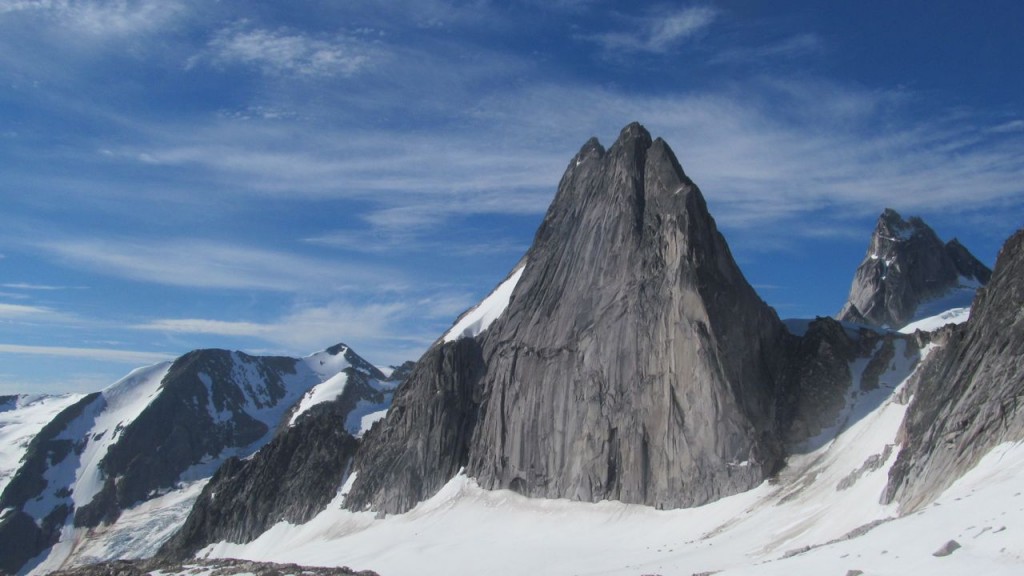“So, you want to rope up?” I ask Anna.
“I’ve been on a glacier once, that was in the Winds” she replies. “So it is your call.”
I hesitate and my mind wanders elsewhere. “What do you think are the two most popular routes in this range?” I say after a moment’s contemplation. We are standing at the edge of the mostly snow covered, Upper Vowel Glacier. Ahead of us lies a kilometer of glacier, with a single file track beelining it for the Pigeon-Howser Col. Below and behind us lay the butthole of the Bugs: the Bugaboo-Snowpatch Col. With quickly opening crevasses and falling debris staining its once white slopes with the saddle’s diarrhea, descending into it could be a suicide rap or a death trap.
“Pigeon, I imagine” she responded with out too much hesitation. “I suppose” she continued after a longer pause “that it would either be the Kain or the Northeast Ridge on Bugaboo.”
“Yeah, probably because people claim that Pigeon is so awesome and that it and Kain are two of the “easier” routes up peaks.” I study the snow covered expanse in front of us and internally debate the likelihood and consequences along with the reasons for and against the rope. “So newer, inexperienced climbers have to approach via the Bugaboo – Snowpatch Col for both routes. It seems they probably watch 98% of other climber folks just walk unroped across the glacier and then up the col. And they probably get the wrong idea”
“Yep, it seems like a dangerous, or at least unfortunate, precedent” she says after I have finished my rambling. We are headed down over the Pigeon-Howser Col and into East Creek Basin and our route is pretty straightforward, both technically and routefinding wise.
Why do I do it? I know the consequence and I know that it is high. What is my justification?
I blame it on the human factor. Avalanche expert Ian McCammon identified six concepts that, incorrectly applied, can lead to people traveling in snow covered terrain that is at high risk of sliding. These concepts, correctly applied however, can also serve to keep us alive by helping us not get slowed down in all decision making. As I watched another party trudge, unroped, up the col behind us and two similar parties trekking across the Vowell Glacier intent on Pigeon’s West Ridge, several of McCammon’s six concepts flood my brain’s frontal lobe.

Familiarity: “I have been on this terrain before, no one punched through into a crevasse”, or maybe “I’ve been on terrain like this in Patagonia. It was fine.”
Acceptance: It is just easier to go along with the crowd than to speak up and mention a hazard or potential risky situation. Nobody else is wearing helmets or everybody else is shunning the rope, why should I mention it to my partner.
Commitment: “We said we were going to go climb in Becky-Chouinard and to do so we have to climb the Bugaboo – Snowpatch Col. It looks in shitty condition with a lot of falling rocks and opening crevasses. Let’s just go up it cause it would be too much work to go around Snowpatch at this point”
Expert Halo: It is easy to look around and see what everyone else is doing. “Oh, hey, that guy is a guide. I saw he didn’t rope his clients up” or “she climbs here all the time and doesn’t rope up for the Vowell Glacier crossing.” As a newer climber it can feel like everyone is more experienced and following other’s examples seems a reasonable thing to do, even in the face of obvious objective signs/facts.
Tracks: In skiing it is easy to see where people went. Glacier travel is no different, though it is harder to tell the more important details of style or techniques. Then there is the idea that no one has previously fallen through, therefore tracks make it safer.
Scarcity: McCammon mentions the idea of the scarcity of fresh powder and that untracked terrain is prime real estate. Climbers are no different. We all want to be first on the route and there are limited routes out there and certainly people bunch up on the popular ones. The convenience of not roping up and moving quicker in order to be first is appetizing for sure.
As humans we use heuristics as a means to facilitate common everyday decisions. Heuristics are the well ingrained ideas that stop us from getting bogged down while making simple or common decisions. Intuition, trial and error, stereotyping, and models are all heuristics. Two other commonly used heuristics are Prior Commitment (we have spent a lot of time or energy invested in something so it just makes sense to keep trying it) or the Availability heuristic (where we make a decision based on the availability, or lack thereof, of examples that support our question). Traveling over rough terrain is a prime example of where heuristics help us make decisions in a quick and efficient method. Knowing that our body can (or can’t) handle certain movements and knowing from past experience (the Similarity or Familiarity heuristic) whether the rocks or terrain look stable and “intuitively” (which is a heuristic) knowing how to control our body dictates a person’s ability to move efficiently through rough or varied terrain. Having this storehouse of kinesthetic knowledge combined with experience in the terrain allows an experienced traveler to move quickly while lack of either experience in the terrain, kinesthetic knowledge, or both forces the novice to slow down and think (perhaps an Unfamiliarity heuristic – lets slow down and think it through). This starts the development of experience that can eventually allow a new heuristic to take over.
I turn and look at the party behind us and think that indeed, while not intimately familiar with the Bugaboos, I am indeed an expert in this TYPE of terrain. I swat, as if at an invisible mosquito buzzing around my head, trying to knock the halo off. Experience tells me the consequence is high. Experience tells me I have little experience with this glacier, this snowpack, and this year’s climate.
Follow the tracks and be aware of the any cracks opening up around the boot pack, I think. Consequence is high, and I have no truly compelling/good reason to not rope up. When coming up the Bugaboo-Snowpatch Col moving quickly to avoid rockfall is a worthy argument. Moving unroped in this situation allows us to lessen the risk of being hit by rockfall. That argument is moot now though as there is little chance of us being hit by rockfall out on the Vowell Glacier.
I can’t help but notice that much like Anna and I, the unroped party that ascended the col behind us were all wearing helmets and crampons and had their ice axes out. I guess as Conrad Kain said, “half a loaf is better than none at all.” They are intent on Surf’s Up, which is on the west side of Snowpatch Spire. They descend the small scree slope, crampons scraping and sliding over the dirt and rock and step onto the glacier. After a quick break they move onward toward their objective.
“Yeah, so lets do this unroped” I say. I have never traveled through this terrain, but the snowpack in front of us appears solid without open crevasses and there is a beat in path.
“OK” Anna responds. We reach down pick up our ice axes and step onto the well trodden boot packed path via the lightly travelled way of a conscious choice.
Afterward: Two days later we rope up for the return up the glacier in East Creek Basin and make our way over to the butthole of the Bugaboos to find it heavily melted out and riddled with rock fall. Unbeknownst to us on the previous day our friend Ben’s rope had been cut in two by rockfall while he was rappelling and he was hit by the rock. On the same day there were two other rescues in the col due to various factors. I took a look at the col and did not feel comfortable descending it, so I convinced Anna to take the long way around, circumnavigating Snowpatch Spire in the process.
